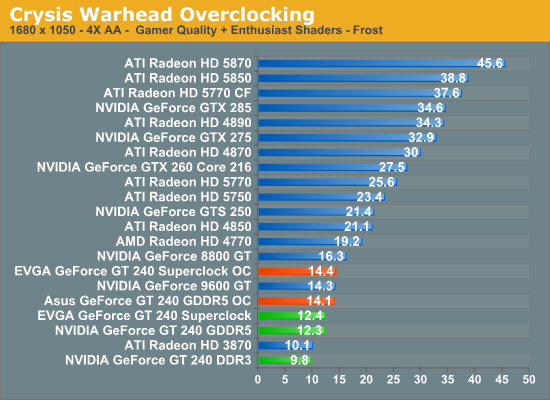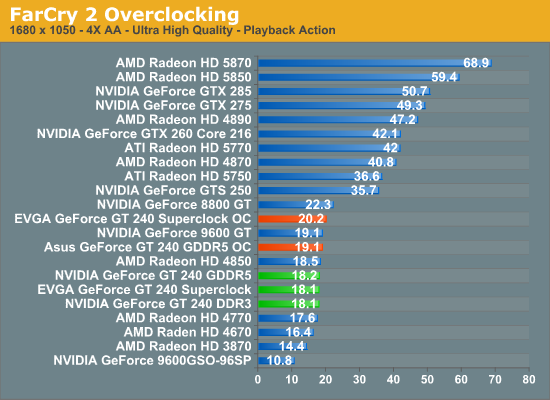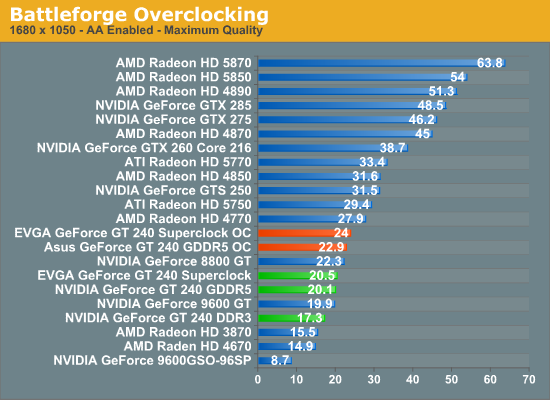NVIDIA’s GeForce GT 240: The Card That Doesn't Matter
by Ryan Smith on January 6, 2010 12:00 AM EST- Posted in
- GPUs
Overclocking
As we briefly mentioned in the introduction, the GT 240 has a 70W TDP, one we believe to be chosen specifically to get as much out of the card as possible without breaking the 75W limit of a PCIe slot. Based on the lower core and shader clock speeds of the GT 240 compared to the GT 220 (not to mention the 8800 GT) we believe it to be a reasonable assumption that the GPU is capable of a great deal more, so long as you’re willing to throw the 75W limit out the window.
There’s also the matter of the RAM. The DDR3 card is a lost cause anyhow thanks to its low performance and the fact that it’s only 10MHz below its RAM’s rated limit, but the GDDR5 cards have great potential. The Samsung chips on those cards are rated for 4000MHz effective, some 17% more than the stock speed of 3400MHz effective. If the memory bus can hold up, then that’s a freebie overclock.
So with that in mind, we took to overclocking our two GDDR5 cards: The Asus GT 240 512MB GDDR5, and the EVGA GT 240 512MB GDDR5 Superclocked.
For the Asus card, we managed to bring it to 640MHz core, 4000MHz RAM, and 1475MHz shader clock. This is an improvement of 16%, 17%, and 10% respectively. We believe that this card is actually capable of more, but we have encountered an interesting quirk with it.
When we attempt to define custom clock speeds on it, our watt meter shows the power usage of our test rig dropping by a few watts, which under normal circumstances doesn’t make any sense. We suspect that the voltage on the GPU core is being reduced when the card is overclocked, however there’s currently no way to read the GPU voltage of a GT 240, so we can’t confirm this. However it does fit all of our data, and makes even more sense once we look at the EVGA card.
For the EVGA card, we managed to bring it to 650MHz core, 4000MHz RAM, and 1700MHz shader clock. This is an improvement of 18%, 11%, and 27% respectively.
Compared to our Asus card, we do not get any anomalous power readings when attempting to overclock it, so if our GPU core voltage theory is correct, then this would explain why the two cards overclocked so differently. In any case, the significant shader overclocking should be quite beneficial in what shader-bound situations exist for the GT 240.

Crysis gives us some very interesting results when overclocked, and this data helps cement the idea that Crysis is ROP-bound on the GT 240. Compared to a stock GT 240, our overclocked Asus and EVGA cards get roughly 15% and 17% more performance. More interestingly, they’re only a few tenths of a frame apart, even though the EVGA card has its shaders clocked significantly higher.
As the performance difference almost perfectly matches the core overclock, this makes Crysis an excellent candidate for proving that the GT 240 can be ROP-bound. It’s a shame that the GT 240’s core doesn’t overclock more than the shaders, as given the ROP weakness we’d rather have more core clockspeed than shader clockspeed in our overclocking efforts.

When it comes to Far Cry 2, the significant shader speed differences finally make themselves more apparent. Our cards are still suffering from RAM limitations, but it’s still enough to get another 10% out of the EVGA card.

Finally with Battleforge we can see a full stratification of results. The overclocked EVGA card is some 19% faster than a stock GT 240, and 5% faster than the overclocked Asus. Meanwhile the Asus is 14% faster than stock, even with its more limited shader overclock.
Finally, on a quick note we’ll talk about power usage. As we mentioned previously only the EVGA card behaved correctly when overclocking – in overclocking that card we saw a 21W jump from 172W under load to 193W under load. If indeed that card is at or close to 70W under normal circumstances as NVIDIA’s specifications call for, then when overclocked it’s over 90W. It becomes readily apparent here that the clock speeds of the GT 240 were picked by NVIDIA to meet the PCIe power limit rather than the capabilities of the GPU itself.










55 Comments
View All Comments
samspqr - Wednesday, January 6, 2010 - link
the cards are in shops already, firmly in 9800gt territory, and nearly 20% more expensive than 9600gt... but at these prices it means you're just paying a $10 premium in order to have the newer card; ati's replacement of 4870/4850 with 5770/5750 meant a much bigger premium for new-but-equally-performing tech (you had bigger power savings there, though)and, of course, I missed some comparisons with ATI cards in the conclusion, something to the tune of: "in any case, it is just sad that nvidia is unable to manufacture new chips to compete with anything ati has, other than a 4670"
nafhan - Wednesday, January 6, 2010 - link
The reason ATI can have a big premium on the 57XX (and 58XX) is that they've got no competition. The 57XX series in particular has PLENTY of room to drop in price as it's a much simpler card to build than the 4850/70 cards that it is replacing. Nvidia has similar performance for a similar price, but it's based on older tech with higher power consumption. The prices will probably stick until Nvidia comes out with a real challenger for the 5 series (i.e. Fermi).Spoelie - Wednesday, January 6, 2010 - link
Why is the GT240 only compared to nvidia cards in the entire review (except for the benchmark images)? It would be to the benefit of the reader to also know how it compares to ATi in the value for money area. What is the current price of say a 4670/4770/4850 in 512MB/1GB configurations and how would that compare in terms of value?Also, with such a small impact, I think the evga card should have been left out of the factory-clock benchmark graphs for future lookup convenience & easy relative comparison. The performance difference compared to the normal card could have been summarized on a dedicated page.
pugster - Wednesday, January 6, 2010 - link
http://www.newegg.com/Product/Product.aspx?Item=N8...">http://www.newegg.com/Product/Product.a...=AFC-Ben...Saw on newegg that you can get this 240gt with 1gb ddr3 memory for $58 after rebate.
plague911 - Wednesday, January 6, 2010 - link
I think the over all point was that you may as well not even consider the GT240. If you wanted a generic ATI/NVIDIA comparison you would use a different nvidia card. Not to say that nvidia may not beat ATI in a comparison but a different nvidia would be a better choice for the comparisonRyan Smith - Wednesday, January 6, 2010 - link
The 4800 and 4700 series have effectively been discontinued, the remaining cards are fairly rare and usually overpriced. There's little to gain comparing the GT 240 to a 4770 or 4850, as you can no longer get ahold of those cards for reasonable prices most of the time.That leaves the 4670, which the GT 240 beats.
hydrocarbon - Wednesday, January 6, 2010 - link
I can grab a 1GB 4850 off NewEgg now for a hundred and ten bucks, or a 512MB for a hundred. "Rare", sure, but "overpriced"? They're cheaper now than they've ever been, especially if you consider those are prices w/o rebates.MadMan007 - Wednesday, January 6, 2010 - link
Just FYI there is such a thing as the used video card market ;) while you can't compare pricing yourself and include it in the written details a savvy user who is looking at used cards will be able to do so.Taft12 - Wednesday, January 6, 2010 - link
Yes, but bear in mind the lack of warranty (XFX double lifetime notwithstanding) and unknown overclocking/stress history. These things make used video card purchases a non-starter.Taft12 - Wednesday, January 6, 2010 - link
... a non-starter IMHO of course